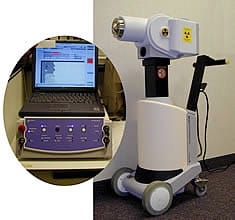What is High-Dose Rate (HDR) Brachytherapy?

HDR brachytherapy is a form of internal radiation where a cancer doctor:
- Implants a small plastic tube or balloon (a catheter) in the tumor.
- Places highly radioactive material inside your body for a short time and then takes it out using a remote control.
- Removes the tube after you've finished your whole course of treatment.
You may need more than one session of HDR brachytherapy.
Contact Us About Radiation Oncology at UPMC Hillman Cancer Center
To learn more about radiation treatments or to make an appointment you can:
- Call 412-647-2811
- Contact a UPMC Hillman Cancer Center near you.
High-Dose Rate (HDR) Brachytherapy Vs. Low-Dose Rate (LDR) Brachytherapy
There are two basic types of brachytherapy treatment:
- Low-dose rate (LDR) implants.
- High-dose rate (HDR) implants.
You and your doctor will talk about which one is best for you.
HDR
HDR implants place a source of radiation through tubes into the body to kill cancer cells. Doctors remove the source in minutes, so no radiation stays in the body.
HDR helps treat:
- Prostate cancer.
- Breast cancer.
- Lung cancer.
- Cervical cancer.
- Head and neck cancers.
- Sarcoma.
- Melanoma.
LDR
LDR implants place radioactive seeds in the tumor site. They slowly release radiation over a few months before they decay.
Doctors may use LDR implants for:
- Prostate cancer.
- Brain tumors.
HDR Brachytherapy for Certain Cancers
At UPMC Hillman Cancer Center, we often use HDR brachytherapy to treat cancers near the outside of the body.
Get details on treatments based on your cancer type:
- Endobronchial brachytherapy for lung cancer.
- LDR seed implants for prostate cancer.
- HDR brachytherapy for sarcoma and melanoma.
- MammoSite® brachytherapy for breast cancer.
HDR brachytherapy for prostate cancer
HDR prostate brachytherapy can be a good choice for treating prostate cancer. If your cancer is in the early stages, it may be the only treatment you need.
During HDR brachytherapy for prostate cancer, your doctor will:
- Insert thin tubes into your prostate while you're under anesthesia.
- Guide a source of radiation through the tubes into the prostate for minutes at a time. The cancer receives most of the radiation, while nearby healthy tissue gets a small dose.
- Either remove the tubes or keep them in place if you need more rounds of HDR treatment.
- Instruct you about your recovery.
 UPMC
UPMC
 UPMC Children's Hospital of Pittsburgh
UPMC Children's Hospital of Pittsburgh
 UPMC Magee-Womens Hospital
UPMC Magee-Womens Hospital
 UPMC Immune Transplant and Therapy Center
UPMC Immune Transplant and Therapy Center

